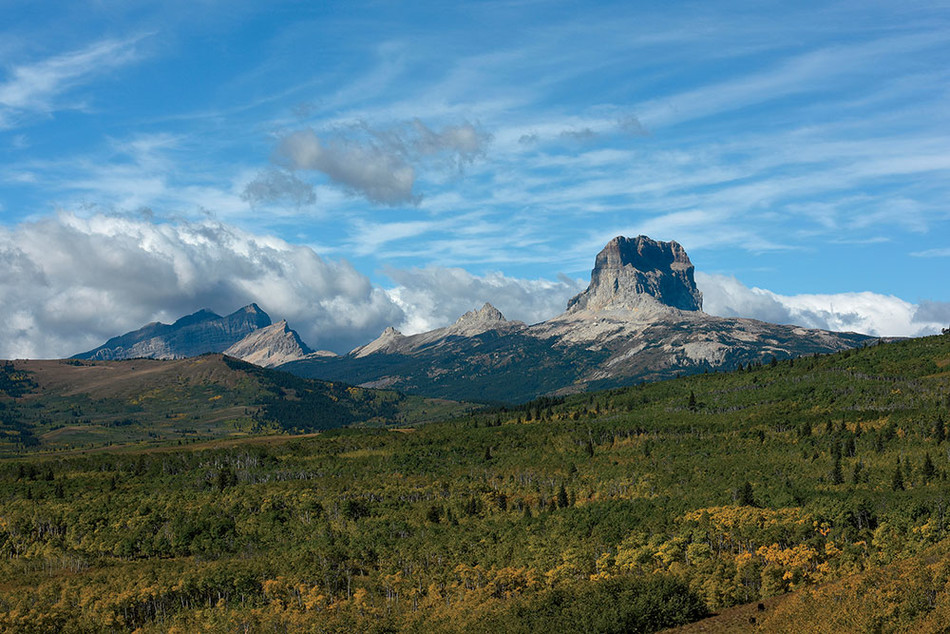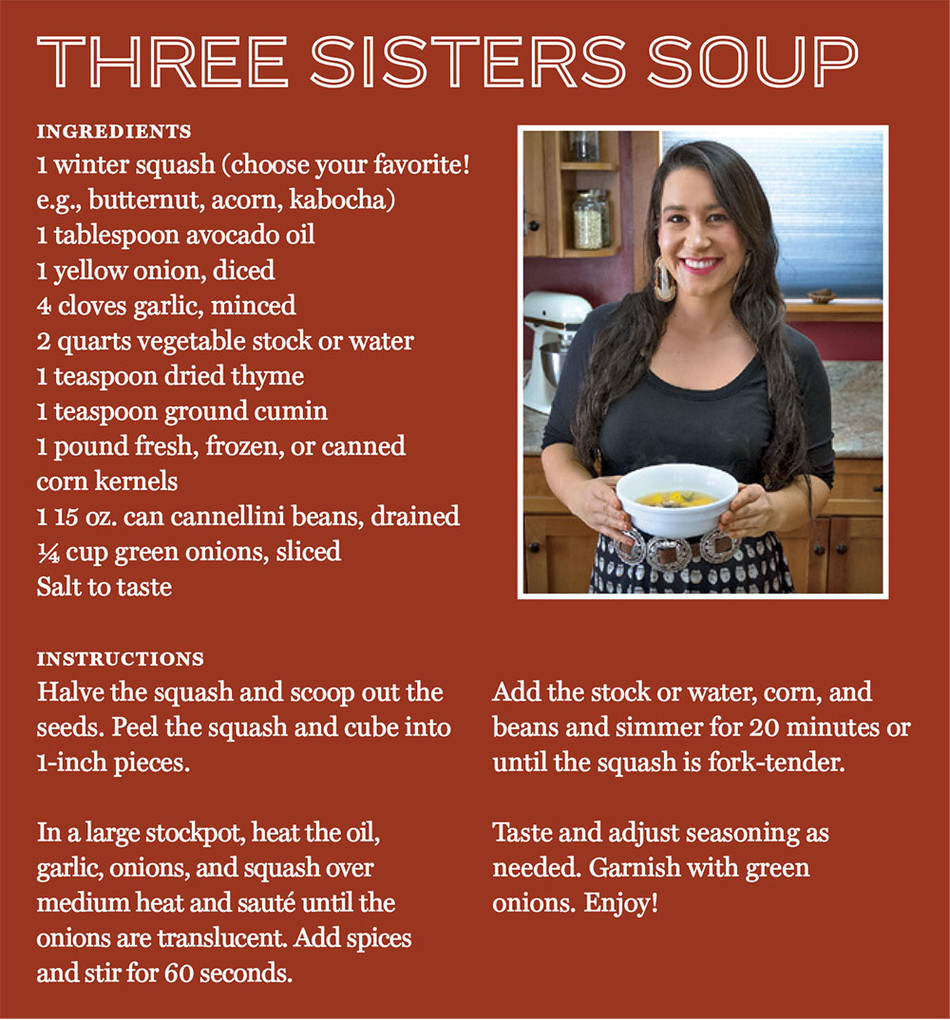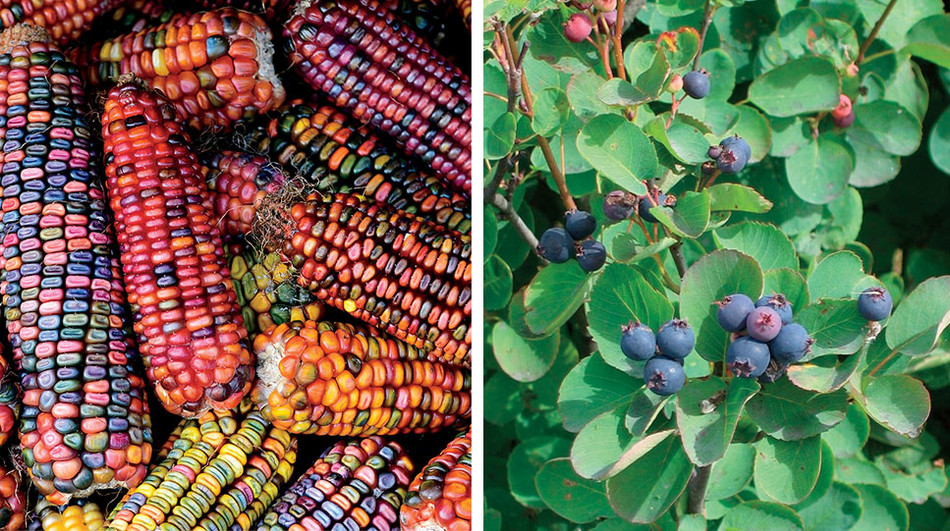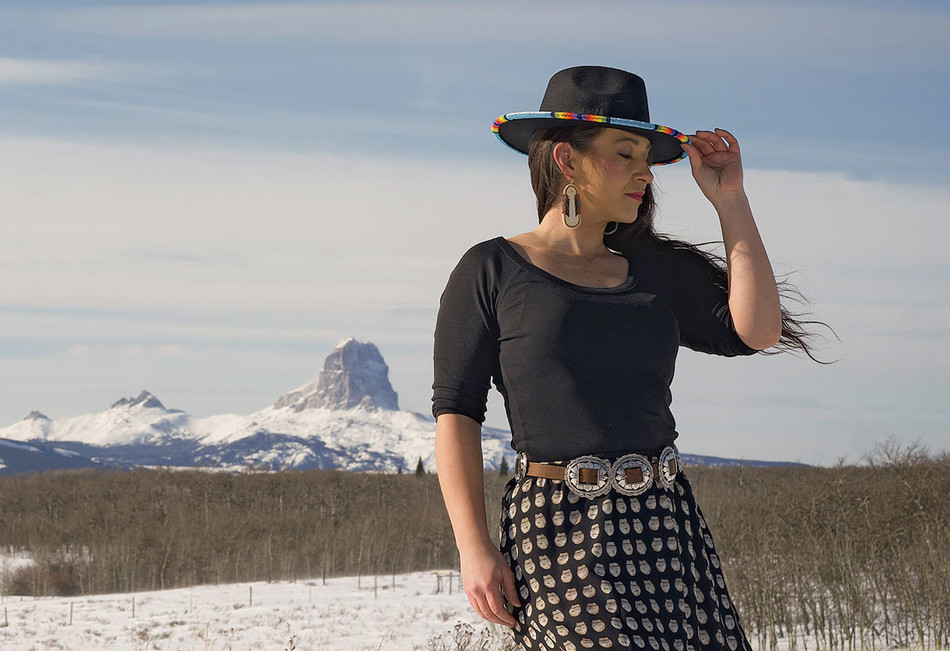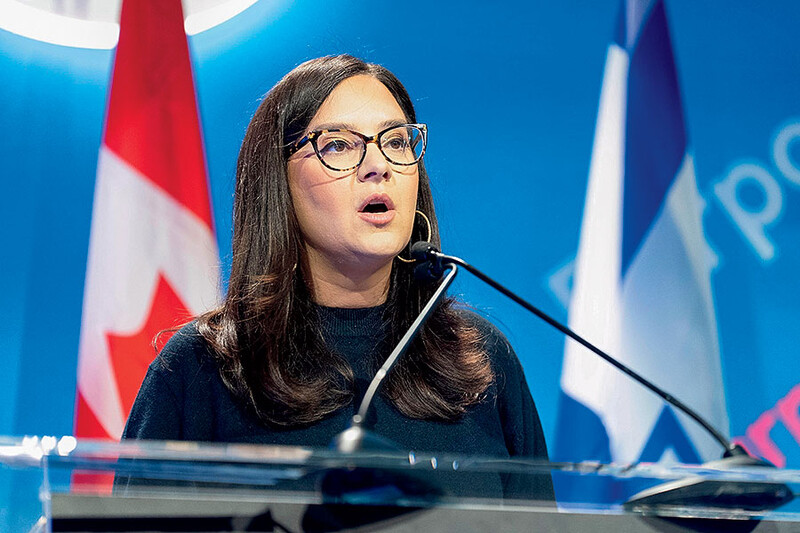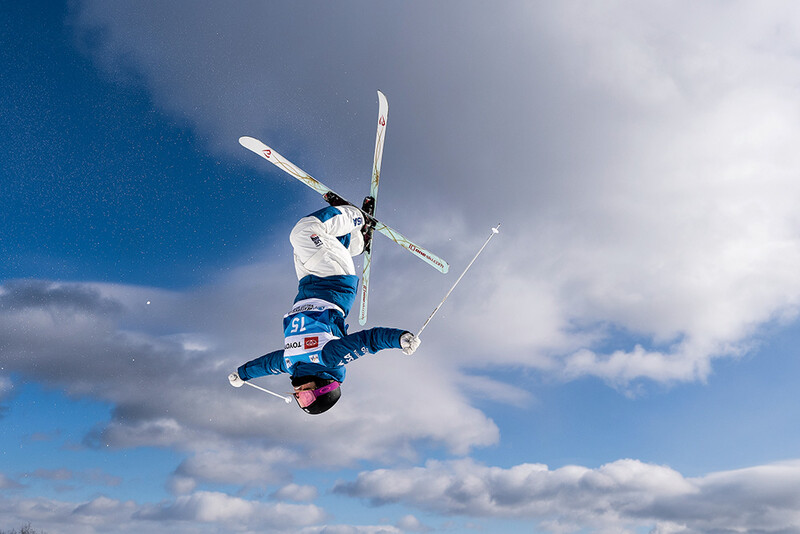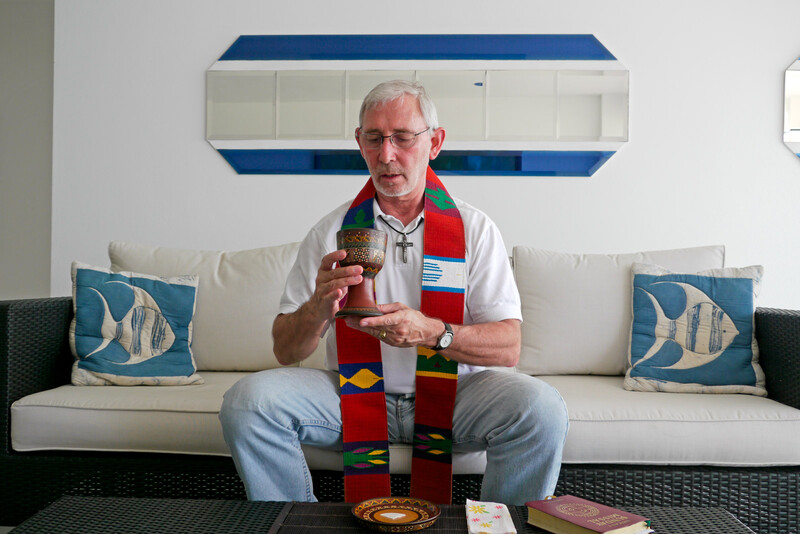Putting Native Foods Back into Native Diets
It’s a rainy day in Babb, Montana, and as a pot of cedar tea simmers on the stove, Mariah Gladstone ’15SEAS looks into the camera and explains the medicinal purposes of the traditional brew. She discusses the tradeoff between using tender new sprigs (better, sweeter flavor) and older growth (higher in vitamin C). She reassures viewers that other conifers, including pine and juniper, also make excellent teas and then offers a quick lesson in harvesting branches without damaging the trees. To accompany the beverage, she crisps up some sunflower maple cookies in a frying pan, noting the dough balls can also be eaten raw or, “if you want to get really fancy,” topped with berries.
In segments for her online cooking show Indigikitchen, Gladstone, the daughter of a Cherokee mother and a Blackfeet father, demonstrates how to make a variety of dishes featuring traditional Native foods: amaranth crackers, white-bean coffee cake, sweet-potato hash browns, pumpkin soup, chokecherry-braised rabbit, blue-corn-crusted whitefish, and more. Just like cedar, sunflowers, and maple syrup, the main ingredients in these recipes have been consumed for thousands of years by inhabitants of the lands now called the Americas.
A portmanteau of the words Indigenous, digital, and kitchen, Indigikitchen, which began in 2016 as a collection of cooking videos that Gladstone produced in her free time, has grown into a thriving one-woman business of the same name. Gladstone has more than twenty-four thousand total followers on YouTube, Instagram, and Facebook, and she reaches many more people via demonstrations, classes, speaking engagements, and consulting gigs.
“I started with the recipes in the kitchen, but I’ve branched out into a larger context of food-systems knowledge, really looking at the process of seed to plate,” she says. That includes helping to build gardens and supporting Native food producers, as well as teaching the history of how colonization disrupted Indigenous foodways.
“Every day I get to do something different. But it all serves the same purpose,” she says. “Ultimately, I want people to eat more Indigenous foods.”
In particular, Gladstone wants Indigenous people to eat more Indigenous foods. In her videos, she extols the nutritional benefits of game meat and fish, berries and seeds, root vegetables and legumes, and numerous other seasonal foods on which Native American diets were based before contact with Europeans. “Those diets transitioned rapidly from high-protein, high-fat, high-fiber, and very few grains to a lot of empty carbohydrates — and now a lot of preservatives or processed foods,” she says. Re-embracing traditional foods, she believes, will not only reconnect people with their ancestral culture but will also help to counteract the diet-related health crisis in Indigenous communities.
“Native people face sky-high rates of diabetes, obesity, malnutrition, and heart disease,” she says. “We also have higher mortality rates from those diet-related illnesses than non-Native populations. In Montana, we have life expectancies of twenty years less than the non-Native population.”
Gladstone, who was raised in the city of Kalispell, in northwestern Montana, says her own upbringing “was relatively privileged compared to a lot of folks.” She spent summers on the Blackfeet Indian Reservation, where she saw the effects of this public-health crisis but didn’t know much about its causes until her college years. Her mother, Linda Howard, was working at that time as a marketing officer for the Montana Department of Agriculture while writing a thesis for her master’s degree in public relations. Howard told Gladstone about her research, part of which evaluated awareness within reservation communities of the term “food sovereignty” and of programs created to foster it. Today, Gladstone can readily recite a widely adopted definition of the term put forth by the international farmers’ organization La Via Campesina: “the right of peoples to healthy, affordable food that is culturally appropriate and harvested through ecologically sound and sustainable methods, and the right to govern those food systems.”
When Indigenous people were disconnected from their traditional foods, the transmission of ancestral knowledge about those foods was also disrupted.
Her mother’s thesis got Gladstone wondering exactly how achieving food sovereignty had become such a struggle within Indigenous nations. As she read more about the topic, she found “a lot of evidence of intentional disruption in food systems that was caused by both the US and Canadian governments.” For example, she says, the US government’s deliberate near-eradication of the buffalo population in the nineteenth century destroyed a major resource for her ancestors, “not just for food but also clothing, shelter, tools, everything. We Blackfeet were starved into selling the lands that are currently the eastern half of Glacier National Park.” She says many tribes became dependent on government rations, which included things they weren’t accustomed to eating, such as wheat flour and sugar. “There was also a law passed by Congress which said that they could cut off our rations if we didn’t send our kids to boarding school,” Gladstone says, referring to federal schools established to forcibly separate Native children from their families and strip them of their identities and culture.
Confronting this painful history and its part in dismantling the Native American diet is part of Indigikitchen’s mission. “I talk about issues that a lot of people wouldn’t touch,” she says. “But because it’s through food as the vehicle, it’s a lot more approachable — it becomes storytelling.”
When Indigenous people were disconnected from their traditional foods, the transmission of ancestral knowledge about those foods was also disrupted. Growing up, Gladstone had absorbed some wisdom from family and community elders: where to forage for serviceberries, for example, or the many household uses of peppermint. During summers home from college, she began to research the subject in earnest.
“I was at my dad’s house on the reservation — without running water, about thirty-five miles away from the nearest grocery store,” she recalls. “I started thinking about where I could get food. I realized that there were a ton of foods right outside the front door. I ended up, of course, picking gallons of berries but also learning about fireweed.” The shoots of the fuchsia-blossomed stalks, which grow throughout much of the Northern Hemisphere, can be steamed like asparagus, and the leaves and flowers are edible as well. She wondered what other food sources she might have overlooked. “I was working as a park ranger, too, so I spent a lot of time in a booth at our entrance gate reading plant-identification books. I started getting a lot more interested in the botany of the landscape.”
The Native ingredients that interest Gladstone come from landscapes all over Turtle Island (a name used by some Indigenous peoples to refer to North and Central America). She often cooks them using tools her forebears didn’t have; she’s particularly fond of her Instant Pot. She also takes inspiration from around the world, concocting her own versions of pad thai with zucchini noodles and of lasagna layered with butternut squash and bison. “We can keep blending and sharing and recreating,” she says. “Our culinary traditions are not stuck in the past, and neither are we.”
Gladstone sometimes jokes that Indigikitchen, with its emphasis on living off the land, is preparing people to survive the zombie apocalypse. “Part of the reason I picked Columbia,” she says with a relatively straight face, “is because it’s zombie-proof: you can just seal the gates and walk around in the tunnels under the campus.”
If the walking dead had invaded Morningside Heights during Gladstone’s college years, sheltering in her dorm might not have been such a bad option. In the basement kitchen of Manhattan House (the Native residential community in River Hall, since relocated and renamed Indigehouse), she turned out elaborate late-night desserts for her suitemates to distract herself from exams. Food figured prominently in the community-building she participated in as a member of Columbia’s Native American Council and as president of the group that organizes the University’s Native American Heritage Month.
At school she yearned for the foods she’d grown up eating. Like bison: ubiquitous in her home state, elusive in New York City beyond upscale burger menus. Or wild rice, which her father, the musician Jack Gladstone, received as payment for performances in the Great Lakes region and used in everything from soups to omelets. More than once, she flew back to Columbia after winter break with frozen moose or elk meat packed in her carry-on bag (“I remember thinking, If they lose my luggage, I do not want this to thaw”).
Gladstone had applied early-decision to Columbia because she liked its approach to environmental engineering “as a proactive solution rather than a reactive solution.” She recalls being disturbed during high school by seeing the flares of natural-gas wells as she drove across the Blackfeet Reservation and hearing worried discussions about the effect of hydraulic fracturing on the soil. “I wanted to get in and find a different solution rather than being the person who says no.” Given her region’s powerful winds and plentiful sunshine, she figured studying renewable-energy technologies was a proactive way to join the conversation.
She returned to Montana after graduation to settle in Babb, a small town on the reservation surrounded by lakes, mountains, prairies, and aspens. She had her degree in environmental engineering, but her career didn’t proceed as she expected. “By the time I got back home, my community had already shut down a lot of that natural-gas development. The wells had been filled with cement, the roads were back to prairies,” she says.
She took a management job in the engineering department of BNSF Railway but during her time off pursued her growing interest in traditional food. In 2016, she attended a Native nutrition conference in Minneapolis, and after making a spontaneous comment that “someone” should start an Indigenous cooking show, she decided to be that someone. She bought a camera on eBay, secured it to a tripod with a headband, and filmed her first recipe: a berry-studded Potawatomi wild-rice dish that her classmate Lakota Pochedley ’13CC had often brought to potlucks on campus.
“Like most millennials — like most everybody — when I want to learn something, whether that’s how to snake a drain or how to cook a recipe, I go to YouTube,” she says. “I wanted to make our traditional recipes Googleable in that way.”
Indigikitchen has been Gladstone’s full-time job since 2018. Over the years, her videos have evolved. That first clip about berry rice used neither her face nor her voice; it was optimized for social media (and the reservation’s limited Internet bandwidth), with captions and a brisk forty-five-second runtime. She still primarily shoots videos focused entirely on her hands as they chop and stir, though she’s upgraded her overhead filming setup with a sturdier ring light / tripod combo. She’s also started shooting some longer-form videos, like the one about cedar tea, that are more in a classic cooking-show style. But, as she adds with a laugh, “it takes me so long to do those because I have to actually put makeup on.” Sometimes she steps away from the stove to produce tutorials on traditional growing and harvesting skills: starting a compost pile, cleaning and filleting trout, or leaching the bitter tannins from freshly ground acorn flour.
For someone who headed off to college with wind turbines and solar panels in mind, Indigikitchen might seem like a digression, but not to Gladstone. “For me it was all about that foundation in sustainability,” she says. It was important to her to “look at our Indigenous communities as places of abundance rather than places of scarcity.”
To further her work with Indigikitchen, Gladstone completed a master’s degree in 2021 at the SUNY College of Environmental Science and Forestry in coupled natural and human systems. Her adviser was botanist Robin Wall Kimmerer, a member of the Citizen Potawatomi Nation and the author of the best-selling essay collection Braiding Sweetgrass. Kimmerer has written extensively on the reciprocity between humans and nature, and Gladstone admires how Kimmerer discusses the concept, which is important to many Indigenous cultures, in a way broader audiences can embrace. “A lot of foods were traditionally thought of as gifts,” Gladstone explains. “They were gifts from the earth, gifts from different plants and animals. And when you’re given a gift, it is often with the responsibility to return a gift.” She hopes Indigikitchen will encourage ecological responsibility, including among non-Indigenous people who might find her content through curiosity about diverse cuisines or healthful eating.
“A lot of foods were traditionally thought of as gifts. They were gifts from the earth, gifts from different plants and animals. And when you’re given a gift, it is often with the responsibility to return a gift.”
“People want to be connected to the land,” she says. “Anyone who knows about where their food comes from — whether it’s from a local farmer down the street or through berry-picking in their backyard — is immediately instilled with a greater desire to care for those places.”
When Gladstone was a child, her dad and grandfather tilled a garden for her. She grew corn, beans, and squash, dubbed the “three sisters” by the Cherokee and other peoples because they can be planted in a mutually beneficial arrangement: corn scaffolding the beans, which enrich the soil, which is sheltered by the squash’s broad leaves. “I got to see the magic of seeds transforming into plants that I could bring into the house and then watch turn into food on my plate,” says Gladstone. “I was lucky to have a really good understanding of where food comes from.”
She knew many other Native kids didn’t grow up with that advantage. Last year, one of Indigikitchen’s projects was to create a toolkit to make it easier for Montana public schools to include Indigenous foods in their meals. The document helps food-service directors identify and procure such foods, match them up with USDA nutrition requirements, and incorporate them into their breakfast and lunch programs. Gladstone also created several videos to educate students about these foods. The project was a collaboration with four reservation school districts and the Montana chapter of the nonprofit No Kid Hungry. According to KayAnn Miller, the organization’s communications and engagement specialist, “the response to the toolkit has been incredible, and it really couldn’t have been created without Mariah.”
Gladstone also serves on the board of FAST (Food Access and Sustainability Team) Blackfeet. The nonprofit’s activities include a food bank, a “food pharmacy” that offers nutrition counseling and cooking classes, and a gardening-education program. “We’re looking at how we build a community that doesn’t need an emergency food supply because we can feed ourselves,” she says.
Gladstone has been recognized as a Champion for Change by the Aspen Institute’s Center for Native American Youth; has delivered a talk on the significance of Indigenous foods at her state’s longest-running TEDx conference; and has advocated before a US Senate committee for legislation allowing tribes to tailor federal food-assistance programs to their local needs and traditions. In 2020 she was selected as an MIT Solve Indigenous Communities fellow, and in 2021 she was featured on the Today show. This series of achievements has raised her profile to the point that she spends more time fielding requests for media appearances than pitching her services. Her job requires frequent travel. Last year she gave demonstrations at the World Food Forum in Rome and planned the menu for a thousand-person banquet at the Intertribal Agriculture Council’s annual conference in Las Vegas. In November — Native American Heritage Month — she slept a total of three nights at home.
While some figures in the growing movement for the revitalization of Native cuisine have gained visibility through their culinary bona fides, Gladstone has never aspired to be a professional chef. She recalls her bemusement when the hotel catering staff for the Las Vegas banquet asked how she wanted the salad cut: “It never occurred to me to cut salad in some particular way!”
Miller sees Gladstone’s down-to-earth approach as a plus. “She’s very straightforward and easy to engage with,” she says. “Mariah’s lessons don’t require special equipment or anything fancy. I can actually cook along with her videos using what’s already on hand in my kitchen, and I can learn about nutrition and health while I’m doing it.”
On social media, Gladstone intersperses food-related posts with glimpses of her hobbies, which include hiking and kayaking, beading earrings, making soap, and performing the occasional acrobatic feat. During college, she tried out an aerial fitness class; she stuck with it when she returned to Montana and now teaches it at a Kalispell studio called Levitation Nation. One video she posted on Twitter shows her suspended high above the floor in a length of twisted fabric. Suddenly she allows herself to unravel and tumble, the silks catching her just before she hits the floor.
“Drops are almost always terrifying the first time,” she says. “But I’m lucky I have folks there that lift me up and support me. And they get less scary the more I do them.”
Gladstone keeps expanding Indigikitchen’s outreach. This year she’s writing an Indigenous cookbook for kids — “It’s super important that kids have a resource that is really their own” — and producing a new video series called Indigikitchen: On the Road, featuring the stories behind recipes crowdsourced from Native contributors across the Americas.
Several of those she interviewed shared anecdotes about the health benefits they’ve experienced from eating more Indigenous ingredients in place of white flour, refined sugar, and other processed foods. “One woman told me, ‘I switched my diet completely. I totally turned things around and reversed my diabetes,’” Gladstone says. “I heard stories like that from people all over who were contributing recipes. That in itself is really cool, and justification for the work I get to do.”
This article appears in the Spring/Summer 2023 print edition of Columbia Magazine with the title "Gifts from the Earth."
